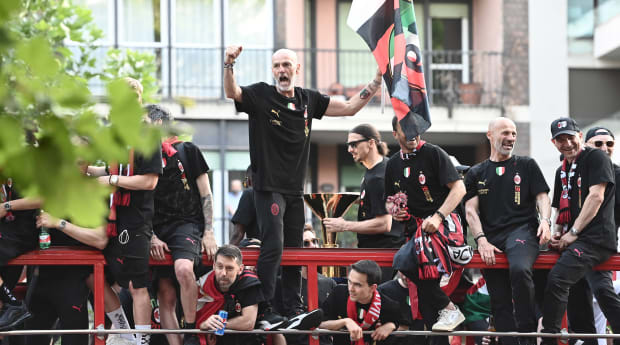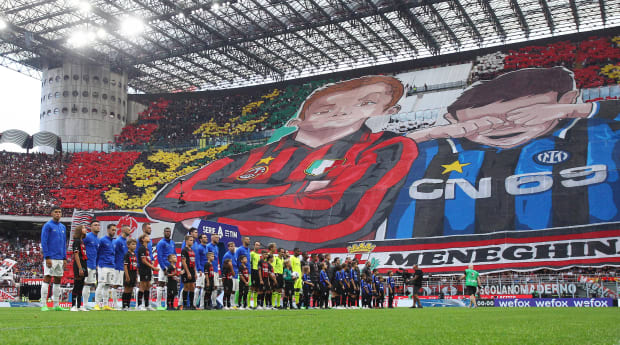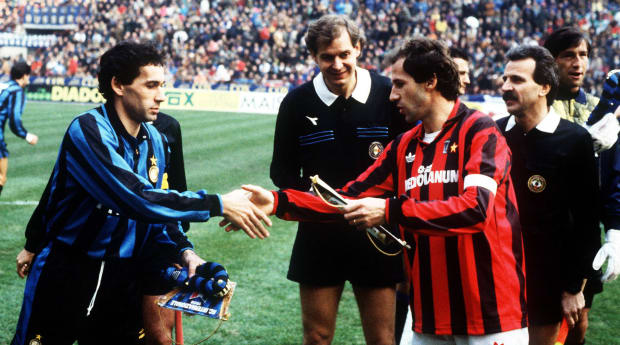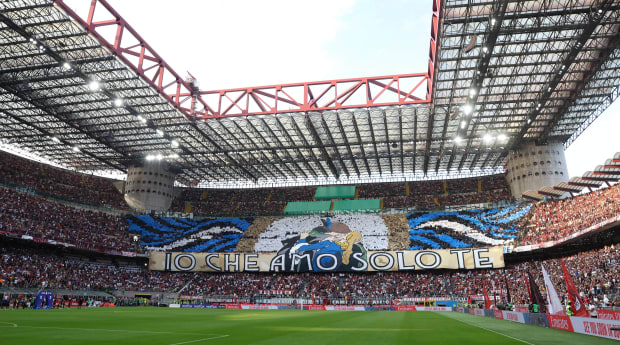The Derby della Madonnina is steeped in tradition, and both of its clubs have returned to prominence. But the stage where future chapters will unfold is about to change.
On the eve of the Milan derby in the northwest corner of the city, a queue crawls around a tattoo parlor covered in chicken-scratch graffiti. Teeming with slow-moving Friday traffic, the street features as many kebab restaurants as pizzerias. If Milan is one of the fashion capitals of the world, Armani and Versace must have missed this part of town.
The people waiting outside the tattoo parlor take numbers like they are at a deli counter. Taped to the walls are six red-and-black mock-ups of tattoos with words like “Milan Forever” and “AC Milan 1899.” Tattoos that would normally cost €150 are free, sponsored by the club. Many of the fans waiting in line say they already have the logo inked, so they opt for more symbolic renditions like the year of the club’s founding.
“People put Milan on their skin because they have Milan in their heart,” says Andrea Costa, owner of Spektrum Tattoo. “It’s better than getting a boyfriend or girlfriend’s name tattooed on your arm, because Milan will never betray you.”
Tattooed geckos and scorpions crawl up Costa’s face; his body is a Rosetta stone of runes and ink. Costa, 47, dips a needle into red ink, and when he scribbles on a Milan fan, one cannot tell whether it is ink or blood. Costa has tattooed recent club icons like Robinho and Gianluigi Donnarumma; he hangs out with club legends like Marco van Basten and Filippo Inzaghi on vacation. And while Costa jokes the club chose him for this project because he’s “the fastest tattoo artist in Milan,” Spektrum Tattoo holds a special place in AC Milan’s recent history.
After clinching AC Milan’s 19th Scudetto with a 3–0 win over Sassuolo in May, manager Stefano Pioli unknowingly had the Serie A medal snatched off his neck by pitch-invading fans during a raucous, prosecco-soaked title celebration. The next morning, Costa etched the number 19 inside an Italian-flag badge onto Pioli’s arm—a trophy that no one could take from him.
“I always said that after my first title [as coach], I would do something that would last—and I did,” Pioli told the media after winning the Scudetto, sporting his fresh ink.

IMAGO/Gribaudi/ImagePhoto
But being king of Italy doesn’t mean you wear your city’s crown. The nature and irony of a derby is that while it is steeped in decades of history and tradition, its glory is fleeting and its memory can be short. Its bragging rights go to the side that won the last scrap. Its currency is revelry or resentment.
When asked whether he would ever tattoo an Inter Milan logo, Costa says, “Sure, but I’ll make them pay double for it.”
Unlike most derbies, Milan’s rivalry is not broken up by neighborhoods or locations, but by families. You are born into AC Milan or Inter like you are given a last name. The hatred is Montague and Capulet.
“My husband, my son, my family—all Milan fans,” says Rossella Durante, who waits for a tattoo of a heart holding the club’s crest in honor of her father. “I’d rather die than see them support Inter.”
It is 24 hours until the Milan derby, where 90 minutes will often seem like a matter of life and death for millions.
The most important figure in the Milan derby is neither Zlatan nor Maldini, not Zanetti nor Meazza, for whom the San Siro stadium is named after. Covered in more than 6,000 sheets of gold and adorned with a star-studded halo, she is three years older than the United States and stands atop the tallest spire of the Duomo, the landmark Gothic cathedral at the center of Milan. She is called the Madonnina—the little Madonna—and she lends her namesake to the match, called the Derby della Madonnina.
The old Milanese tradition says no building can be taller than the Madonnina, which stands 356 feet above the city. When a taller skyscraper is built, the architects often affix a replica Madonnina to the highest point. Except during World War II, when the Madonnina was covered with a tarp so as not to be a target for bombing, she has seen the city flip between red and blue since the first official Milan derby in 1909.
Both clubs were born out of the Milan Cricket and Football Club, founded in 1899 by a group that included English ex-pats. AC Milan still carries the anglicized version of the city’s name rather than the Italian (Milano) as part of that tradition. Italians omit the AC—they are simply Milan. Its founders wanted players to compete like devils, so they chose red for fire and black for the fear it hoped to instill in their opponents.
Nine years later, a group of founding members left over a disagreement concerning the club’s stance on foreign players. Those members founded Internazionale, taking its Nerazzurri colors from the gold stars and the blue-black night when it was founded.

IMAGO/LaPresse
More than a century later, AC Milan and Inter Milan have tallied 19 league titles apiece. The next title will earn them a second star on its jersey, one for every 10 Scudetti. However, Inter Milan holds the official head-to-head matchup with 85 wins to AC Milan’s 79.
The list of players to play for both sides could fill a Hall of Fame: Ronaldo, Andrea Pirlo, Zlatan Ibrahimović, Roberto Baggio, Edgar Davids, Clarence Seedorf, Christian Vieri. But it is a pair of brothers who best represent the ethos of the derby.
In 1971, Giuseppe Baresi successfully tried out for Inter Milan and would go on to make more than 500 appearances for the club. His younger brother, Franco, was turned away. The next year, Franco signed with AC Milan. It was his destiny, he says, a pair of brothers separated by two years and one color.
“Inter wanted to wait a little longer to sign me because they thought I still needed to grow,” Franco Baresi says. “Maybe they were going to wait until the next year. Instead, Milan was more in a rush.”
When Franco turned 18, just after his senior debut for AC Milan, he moved into an apartment in Milan. Waiting for him was a familiar face who also shared the same office at San Siro, and for a handful of years the brothers lived together as rivals and roommates.
“During the week [of the derby] we would still have to see each other,” Franco says. “Whoever won would pay for dinner.”
While Giuseppe was the first to reach stardom as a versatile and tenacious defensive midfielder, it was Franco who would become a national legend. The younger Baresi made more than 700 appearances and spent 15 years as captain of AC Milan, finished second in Ballon d’Or voting in 1989, won the World Cup in ’82 and eventually captained the Italian national team.
Watch soccer live with fuboTV: Start a free trial today!
However, the most iconic image of his career may very well be him and his brother shaking hands at midfield in four years’ worth of Milan derbies, each Baresi brother a captain representing half of a city.

IMAGO/Buzzi
“During the derby week, you run into people on the street who would hold you accountable for it,” Franco says. “Two brothers in two important clubs—that was exciting. It was more than just adversaries, because I had my brother on the other side.”
In the end, the dinners mostly came out even. From Franco’s AC Milan debut in 1978 to Giuseppe’s departure from Inter in ’92, Inter recorded 10 wins, nine draws and nine losses in the Derby della Madonnina.
“Between us there was always a lot of respect,” Franco says. “It didn’t change our relationship. … Sometimes he was happier, sometimes I was.”
While their midfield handshakes continue to be iconic, it may be one of the few times when the Milan derby was cordial. What often awaited was hellfire.
Three hours before Saturday’s derby and the streets around San Siro are consumed by a silent rush. A tide of red and blue is flowing toward the stadium, and everyone is trying to hitch a ride. Taxis don’t bother stopping. The retro rickety trams, a vestige of the old Milan that can also be found as far as San Francisco, are packed so tightly that people at the edge have to be pulled back to avoid falling out when the doors open. Inter fans share Vespas with AC Milan fans, taking swigs of Birra Moretti before passing it down the line at red lights.
Pubs are not part of the pregame experience like in England. If you’re looking to sing songs about the days of old and get drunk on cheap-ish beer, you can save yourself the trip and head straight to San Siro. Fans are already piling into the stadium, spiraling up the iconic box-spring exterior staircases that invoke an optical illusion.
One hour to go and the Curvas are full. It is an AC Milan home game, but each group of ultras sticks to the side it calls home: the Curva Nord (the North End) for Interista, the Curva Sud for Milanista. Insults are volleyed back and forth like the needle of a metronome.
The Curva Nord waves an army of flags to the tune of a persistent drumbeat through to the final whistle; its leaders stand on the dangerous side of a rail that is supposed to keep them from falling 40 feet down to the field. The Curva Sud prefers to employ flailing limbs and middle fingers as their weapons of choice. It is a good thing Saturday is for the derby, because on Sunday they can at least confess their sins to the Madonnina.
Thirty minutes before kickoff, each side unfurls breathtaking tifos that stretch the entire length of each curva and up to San Siro’s top stratum. AC Milan stuns with a mural-like portrait of a celebratory Milanista next to a crying Interista with the caption: “The Milanese tradition.” Inter’s reads “I who loves only you,” adding nerazzurri colors to a famous Italian couple featured in Francesco Hayez’s The Kiss painting. AC Milan then jabs with “I, champion. You, crybaby.” Inter’s retort is simple and eloquent: “STRONZI” (A--holes). Milan fans echo it, spitting their venom at Hakan Çalhanoğlu, who did the unforgivable by leaving AC Milan for Inter Milan before last season.
It all feels like a red carpet or fashion runway, a megaton Medieval Times theme park with red knights and blue knights. All the songs feature curse words screamed louder than the other lyrics, and the air smells like general body odor, hand-rolled cigarettes and the gunpowder of flares. And it is then that you realize while there is a game being played out on the ground, there is also one in the sky.
The air is simply electric, and there is nowhere for the current to go until the goals begin flowing. Inter strikes first in the 21st minute; Milan equalizes seven minutes later. Each side turns into Tolkien Orcs crawling over one another when the ball hits the back of the net. The conceding side employs a gesture with their arms that looks like an elephant flapping its trunk, as if to say, “Yeah, so what?”
A 13-minute stretch featuring three goals at the start of the second half tests the Richter scale. Giroud. Leão. Džeko. Pandora’s box is open, and San Siro is Michelangelo’s The Last Judgment: bodies strewn, hellish scenes abound, the speaking of tongues. And then the choirs ring out from the heavens at San Siro, filling the stadium with song, and your ears guide your eyes upward despite the goals. Worship, gratitude, praise, damnation—like a church.
During the match, somewhere in the ground-level stadium boxes, Donald Trump’s Secretary of State Mike Pompeo and far-right Italian politician Matteo Salvini watch on, surrounded by security—what a pity to be so powerful that you have to stay inside while an entire city pours its soul out in the fifth derby in a calendar year.
The Rossoneri win 3–2, champions of Serie A and kings of Milan. The Madonnina is theirs. The hellfire is spent.
The past scripts of the derby fuel its present theater, but the stage where future derbies will unfold is about to change. Milan already has the Duomo, but if all goes to plan it will soon have The Cathedral.
Populous, the architectural firm behind Wembley Stadium and the new Yankee Stadium, has been tasked with building it. Partly inspired by the Duomo’s façade, the designs are stellar, a mix between a Star Wars base and Central Park. Carbon neutral with 22 acres of green space and recreational centers open to the public, The Cathedral is an attempt at incorporating a new stadium into the fabric of an old community—something that San Siro with its moat of parking lots has never done. The preliminary goal has been to open by 2027, but the Italian bureaucracy is famous for turning aspiration into regret.
The project, which will reportedly cost around $1 billion, will be privately owned and financed by both clubs, a rarity in Italian soccer. In Europe’s top five leagues, there are only two stadiums that host two top-flight teams: San Siro and Rome’s Stadio Olimpico (AS Roma and Lazio), Italy’s two biggest stadiums. In an economic sense, the paths of AC Milan and Inter intertwine in the space where they share a playing surface, and that success is symbiotic. The current stadium is listed as the host of the opening ceremony for the 2026 Winter Olympics; after that, its precise future is not as certain.

IMAGO/Sportimage
AC Milan confirmed that while all options are still on the table, including the possibility of choosing a different site, San Siro will be demolished under the current plan agreed to by both clubs with “the possibility of keeping some vestiges that represent the legacy of the current stadium.” According to the club, the plan is for The Cathedral to be built beside the current stadium so that no temporary playing site would be needed—when ready, the clubs can flip the switch and move next door.
“The ‘tradition’ and the iconic status of the Meazza stadium are intrinsically linked to the legendary stories and successes that both AC Milan and Inter have achieved on the pitch,” AC Milan president Paolo Scaroni says in a statement. “If the clubs go elsewhere, their heritage will remain alive and will be renewed in their new facility, making the new stadium equally special and iconic.”
But the plan has already upset large portions of their fan bases who hold on to the nostalgia of San Siro.
“It’s sad to hear about San Siro,” says Durante with a new tattoo wrapped in cellophane. “The thought of seeing it torn down makes me shudder. It’s always nice to try something new, but San Siro is San Siro.”
A new group of American owners will have a say in where the derby goes from here. RedBird Capital, led by Gerry Cardinale, completed its acquisition of the club last week in a deal reportedly worth $1.2 billion. Investment also came from a group featuring LeBron James and Drake as passive investors, while a minority stake goes to the New York Yankees, which will use its YES Network to showcase AC Milan to the U.S. market. The next day, U.S. men’s national team star Sergiño Dest arrived at the club, on loan from Barcelona and on the bench to witness the derby.
Whatever the future holds for the derby—wherever it is played and whoever plays in it—maybe it’s best to heed the advice of one of its finest actors. For Franco Baresi, San Siro legend, memories cannot just be confined to a place—they require the energy that colors the scene with moments of magic and joy.
“For me, [San Siro] was home for 20 years,” Baresi says. “No one will ever forget what San Siro is and has been for the story of Milan and Inter. … It is a great joy.”
More Soccer Coverage: